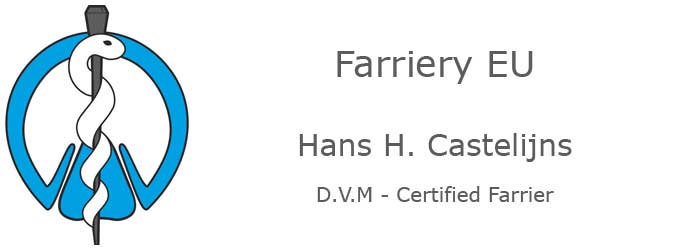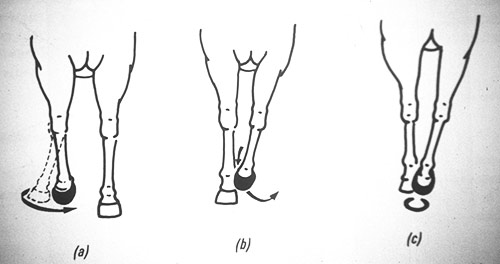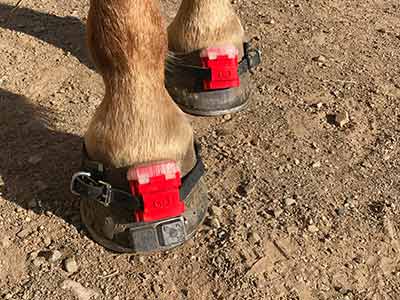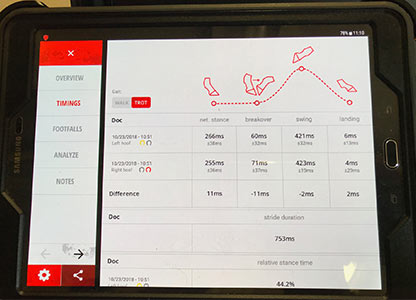 |
“The influence of shoeing on the swing phase of the horse’s limb; what do we suspect, what can we find out.” |
||
Swing phase: The portion of the limb motion cycle when the limb is free from contact with the ground. Definition in “Equine Locomotion”, Willem Back and Hilary Clayton, W.B. Saunders, 2001. |
||
A lot of importance is given by farriers and equine vets on the horse’s interaction with the ground trough their shod or unshod hoofs during the stance phase. The stance phase is divided in the initial contact, mid stance and heel-lift of- toe leaving the ground phase. [Fig. 1 |
||
|
||
In performance however, a lot of importance is given to what happens to the limb(s) in the air, which, for simplicity’s case will be called the swing phase of the limb(s). Examples of equine performance which come to mind are harness racing, dressage, show arabs, Icelandic horses and in general interference injuries. The horse’s movements have for ever fascinated us, the first cinematic study of animal locomotion was done on horses by Eadward Muybridge in California in 1877, proving that in the racing trot there was an aerial phase with all four feet of the ground. The horse has also proved to be a very effective “locomoter”; 80% of the energy the horse needs for forward motion is “for free”. This anatomical specialisation makes the horse’s limbs work more like pogo sticks than most other animal’s limbs; the weight of its body extends the suspensory ligaments, tendons and check ligaments and after the limbs are at the mid-stance phase, these stretched elastic structures propel the body forward when turning to their original length, like loaded springs uncoiling (analogy of professor Renate Weller). This means that the burning of energy during a horse’s locomotion is used in the swing phase when the retracted limb (see the hind right limb on the left horse of fig.1) has to fold up, accelerate and protract in the air in front of the moving horse’s body (see the same horse’s right fore), to then decelerate to close to zero meters per second for initial ground contact of the hoof with the ground. Professor Eize Stamhuis has illustrated (at the last spring games) how, with the body’s speed increasing- by increasing the stride frequency- the limbs must fold up closer to their upper body origin, using the metronome as an example. [fig.2] By sliding the weight on the metronome’s needle closer to its hinge, the tempo (stride frequency) increases. In other words, it is easier to move a mass quickly to and fro if it is closer to the hinge/joint. And of course, it is easier to move the distal part of the limb quickly to and fro if the mass, especially the mass at the bottom is less. |
||
|
||
Fig 2. A metronome used to change the beats per minute (tempo) in music, to increase the tempo, with the same force (spring load of the metronome), the weight on the needle is moved towards its hinge. The metronome depicted here has been turned upside down to make the analogy with the horse’s limb clearer. The horse’s evolution has answered to this need; less mass at the extremity of the limb by elongating the lower limb and depriving it of its (heavy) muscles, thus the muscle interosseous III has become the muscle-less suspensory ligament for instance. Remember basic physics: F (force) = a (acceleration) x m (mass); the less mass the less force (and energy) you need to accelerate the lower limb. Now it is interesting to note that in equine performance we might want to influence the swing phase in very different ways; in race horses we aim for the lightest weight at the extremity (the hoof and shoe), as top speed is the aim, while in dressage or in Icelandic horses we might want to increase the “action”- the folding of the limb- by increasing weight at the hoof level. So much so that the latest sport has quite strict rules on the size of what may be applied to the lower limb in the form of shoes, hoof length, pads and weight of protection. (FIPO 2013, Rules for Icelandic Horse Sport Events, 2.3 Shoeing.) Objects, including horse’s limbs, move through space in three cartesian planes. Not only in the sagittal plane (as seen from the side), but also in the frontal and horizontal planes, as seen from the front and from above. Horses often show deviations from the sagittal plane of the lower limb in the swing phase, as seen from the front. These deviations are correlated with the conformation of the limb and probably with trimming and shoeing techniques. A good example of this is a limb with an – so called- off-sett carpus (“knee”), where the two rows of small carpal bones are not parallel to the ground.[Fig.4] When retracting the lower limb is moved outwards, and when protracting inwards, as can be observed looking at the horse in movement from the front. [Fig.5] |
||
|
||
Ultimately it would be interesting for farriers, vets, coaches and riders to be able to influence these swing phase movements by trimming procedures and shoeing techniques, in a measurable and therefore predictable way. This is, the author believes, one of the prospects of working with the Black system, as the system allows for three-dimensional analysis of the flight path of the hoof. [Fig.6] |
||
|
||
Hans Castelijns
D.V.M - Certified Farrier




